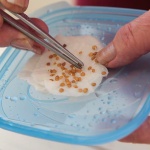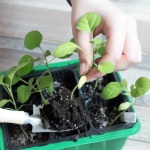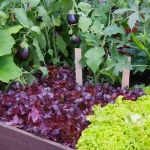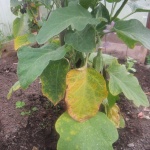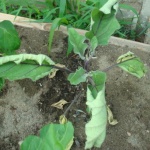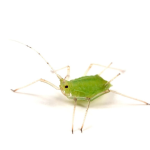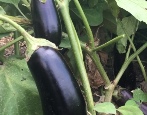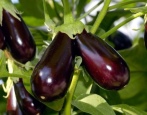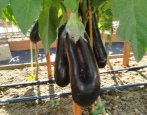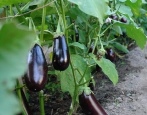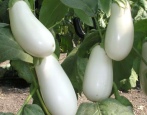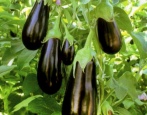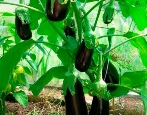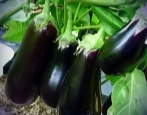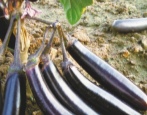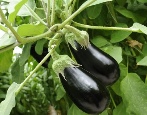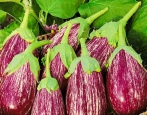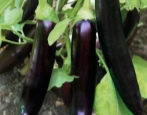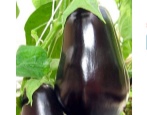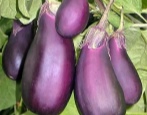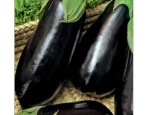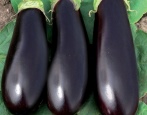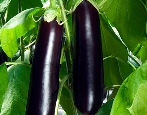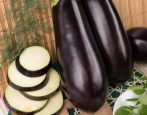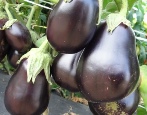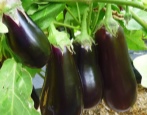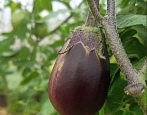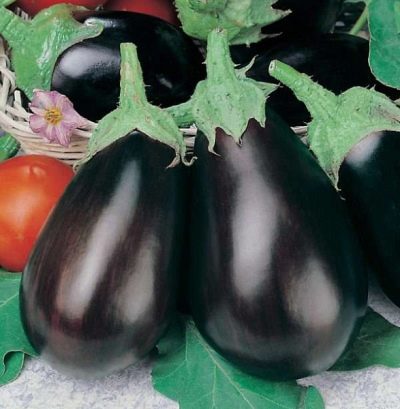
- Authors: Maksimov S.V., Klimenko N.N.
- Year of approval: 2006
- Growth type: medium-sized
- Bush height, cm: 60-75
- Fruit shape: pear-shaped
- Fruit weight, g: 200-250
- Fruit color: brown-purple
- Keeping quality: excellent
- Transportability: excellent
- Ripening terms: mid-season
Eggplant Black handsome appeared relatively recently on the seed market. The variety was included in the State Register in 2006, the originator is the agrofirm "Poisk". However, despite the "youth", the variety managed to please gardeners.
Description of the variety
The black handsome is a very fruitful, early and hardy eggplant, with pot-bellied, weighty fruits without bitterness. He is flawless. Like all eggplants, the variety is thermophilic and demanding, but Russian gardeners rate it very highly.
Characteristics of the appearance of plants and fruits
The bush is of medium height, about 70 cm, slightly spreading. The foliage is medium, with light teeth. Stems are slightly pubescent, purple in color.
The fruits are large enough - 200-250 grams, pear-shaped, elongated, up to 20 cm, more often - 14-15 cm. Diameter - 5-6 cm. The color at the stage of technical ripeness is brown-violet. The skin is smooth, with a vinyl gloss. The pulp is dense, firm, without bitterness and without seeds, white with a yellow tinge. Transportability, keeping quality and commercial qualities are excellent.
Purpose and taste
The taste of the fruits of the Black Krasavets variety is excellent. The pulp is spicy, but without a hint of bitterness. The fruits do not need to be pre-soaked. The application is universal. The fruits are fried, stewed, canned for the winter, processed into caviar. Pear-shaped fruits are very decorative, look beautiful and appetizing.
Ripening terms
The variety is mid-season, the fruits ripen 110-145 days after the emergence of mass shoots. The exact time depends on the temperature. The climate also affects the fruiting period and the final yield. In good years, gardeners remove the eggplants until mid-October.
Yield
The yield is high - 336 kg / ha, at the level of standard varieties. From 1 sq. m is removed in 7-8 kg, and from 1 bush with good agricultural technology, you can get 3 kg. The yield is friendly, the fruits ripen not one by one, but in batches.
Growing regions
The variety is recommended to be grown in the Central Black Earth and North Caucasus regions. But with the observance of agricultural technology, the Black Handsome can grow in other regions of Russia.
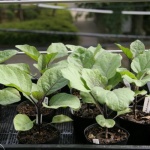
To get a tasty and bountiful eggplant crop, you must first grow strong and healthy seedlings. This culture is considered very capricious, therefore, you need to take care of seedlings when growing at home as correctly and carefully as possible.
Landing scheme
60 cm between plants are kept, in row spacings - 100 cm each.
Growing and care
Eggplants are more demanding than tomatoes and even peppers. The Black handsome variety is quite hardy, but only comparatively. Against the background of other varieties, he shows himself to be prolific and active. In general, like all eggplants, it loves warmth and careful care.
The variety is best grown in greenhouses. In the recommended regions of Russia - in the south, it feels great outdoors. One of the prerequisites for growing a crop is an even warm temperature without zigzags, in the range of + 22 ... + 25 ° С. In the middle lane, already in August it becomes too cold at night, cold dew falls, eggplant flowers stop tying fruits. It is easier to maintain an even climate in a greenhouse.
Sowing seedlings is performed in the first half of March.They are planted in a permanent place only in warm, well-warmed soil - its temperature should be + 15 ° C. In Russia, on average, it is mid-late May, and in some regions, only the beginning of June.
The variety branches well, so you need to shape it. Remove all lateral shoots and leaves prior to first branching. The Black Handsome rarely needs a garter - thick strong branches perfectly hold the weight of the fruit.
Eggplants love regular, but not over-watering. The soil is shed 30 cm - it is at this depth that the root system of plants is located. Water for irrigation should be soft and warm, cold is not acceptable. It is better to pour the liquid into special grooves so that the soil does not have to be loosened, risking damage to the roots. Water according to the weather, usually 2-3 times a week.
Any moisture should be avoided on the leaves. Water droplets from watering can act as lenses. Damaged leaf areas become gateways for infections. They do not like eggplants and foliar feeding. Air humidity should be moderate - up to 70%. If fungal or infectious spots appear on the leaves, you can dust them with ash - such a dry treatment in dry weather can be quite effective.
Watering is best done in the morning. Eggplants are planted in loose, airy soil that dries out rather quickly.
Mulching after watering is very useful. Sprinkle the soil with dry humus, sawdust or straw. The mulch needs to be periodically renewed - once every two weeks, the litter is replaced with a fresh one. Mulching may seem unimportant, but in practice it plays a huge role. Equalizes the temperature in the soil, protecting the plant from temperature extremes, maintains a fairly even humidity regime, eliminating the need for the gardener to thoroughly water the eggplants. It also protects against disease.
Eggplants love top dressing, the Black handsome variety is no exception. Particular attention is paid to potash dressing - this is a symbolic element for the culture. Humic fertilizers are well suited - especially for those who find it difficult to calculate the exact amount of fertilizers. It's hard to overdo it with them.
Diluted chicken droppings, infusion of herbs (ordinary grass, young nettle without seeds, comfrey grass are also suitable), infusion of wood ash.
Towards August, the risk of disease increases. Therefore, plants are regularly spilled with "Fitosporin". This protects against dangerous root rot that many beginners overlook. The affected plant looks just lethargic, it seems that it lacks moisture. However, in reality, the culture is simply not able to assimilate this moisture due to damaged roots.
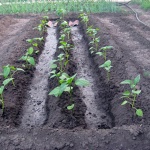
Planting eggplant is one of the most important stages in growing. When choosing a place for eggplants on your site, it is important to remember that this culture should be in warm soil, constantly illuminated by the sun. The plant is also very fond of spacious, open spaces, since its roots can grow over sufficient areas.


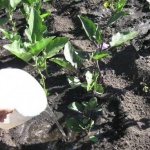
Soil requirements
The soil should be light and nutritious. Rotten sawdust and chopped straw are introduced into heavy soils. Compost and last year's manure will increase the nutritional value of the soil and at the same time its moisture capacity - it will better retain water after irrigation. The addition of low-lying peat is useful. Also, when digging for 1 sq. m distribute wood ash. It is a useful potash fertilizer and disease prevention.
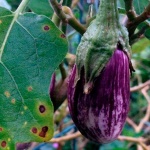
Eggplant is one of the most demanding crops. For its successful cultivation, it is necessary to create optimal conditions, as well as to carry out prevention and fight against diseases and pests. Eggplant often infects both fungal and viral diseases. If treatment is not started on time, you can completely lose the crop.
Review overview
The black handsome is an excellent variety. A rare eggplant gets so many positive ratings, and without any criticism. It grows very well even among beginners, in regions that are difficult for culture. The fruits themselves are simply out of competition. They have delicious, white, milky-tender pulp. There are few or no seeds at all. Suitable for any dish.
Fruits can grow very large - up to 400-500 grams. There may be voids in the fruits, but gardeners willingly forgive this defect for their amazing fleshiness. The plant is very active, in warm regions it can reach 1 meter of growth, it must be formed, otherwise the bush turns into a tree. At the same time, it is very hardy - it does not get sick with anything. There are reviews of severe damage to slugs and aphids, but on average, gardeners do not have problems with them. Many people use stimulants and timely process them with biological products, spray the plant for better tying.
The Black Handsome variety will be especially useful for those who are trying to grow this vegetable for the first time and have heard about the difficulties of cultivating eggplant. The variety can be a pleasant surprise.
